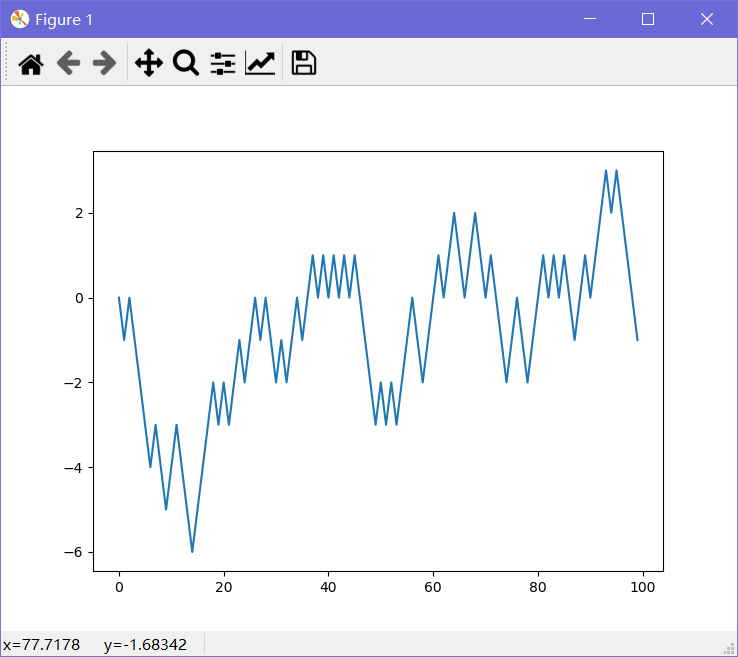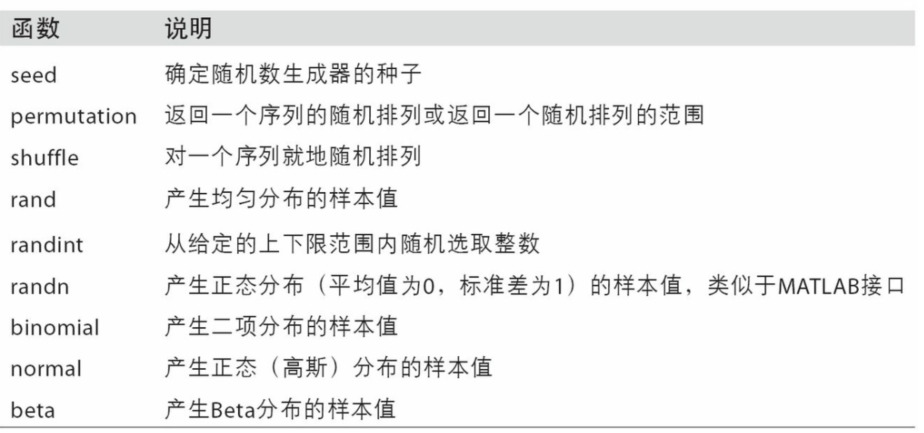NumPy.random
numpy.random模块对Python内置的random进行了补充, 增加了一些用于高效生成多种概率分布的样本值的函数
In [26]: samples = np.random.normal(size=(4,4))In [27]: samplesOut[27]:array([[ 0.80595138, 0.94523723, 0.55290059, -0.49084826],[ 2.76919288, 0.16045781, -1.34777518, -1.10624054],[ 1.79839502, -1.05902345, 0.52886312, 0.08208192],[-0.36451857, -0.27472158, -0.28468561, 0.88335674]])
可以用NumPy的 np.random.seed 更改随机数生成种子
In [28]: np.random.seed(1234)
numpy.random的数据生成函数使用了全局的随机种子。 要避免全局状态, 你可以使用 numpy.random.RandomState , 创建一个与其它隔离的随机数生成器
In [29]: rng = np.random.RandomState(1234)In [30]: rng.randn(10)Out[30]:array([ 0.47143516, -1.19097569, 1.43270697, -0.3126519 , -0.72058873,0.88716294, 0.85958841, -0.6365235 , 0.01569637, -2.24268495])
示例:随机漫步
下面是一个通过内置的random模块以纯Python的方式实现1000步的随机漫步
In [31]: import randomIn [32]: position = 0In [33]: walk = [position]In [34]: steps = 1000In [35]: for i in range(steps):...: step = 1 if random.randint(0, 1) else -1...: position += step...: walk.append(position)...:In [36]: import matplotlib.pyplot as pltIn [37]: plt.plot(walk[:100])Out[37]: [<matplotlib.lines.Line2D at 0x27ba2734b48>]

不难看出, 这其实就是随机漫步中各步的累计和 。用np.random模块一次性随机产生1000个“掷硬币”结果(即两个数中任选一个),将其分别设置为1或-1,然后计算累计和
In [38]: nsteps = 1000In [39]: draws = np.random.randint(0, 2, size=nsteps)In [40]: steps = np.where(draws > 0, 1, -1)In [41]: walk = steps.cumsum()In [42]: walk.min()Out[42]: -9In [43]: walk.max()Out[43]: 60
现在来看一个复杂点的统计任务——首次穿越时间,即随机漫步过程中第一次到达某个特定值的时间。假设我想要知道本次随机漫步需要多久才能距离初始0点至少10步远(任一方向均可)。 np.abs(walk)>=10 可以得到一个布尔型数组,它表示的是距离是否达到或超过10,而我们想要知道的是第一个10或-10的索引。可以用argmax来解决这个问题,它返回的是该布尔型数组第一个最大值的索引(True就是最大值)
In [44]: (np.abs(walk) >= 10).argmax()Out[44]: 297
注意,这里使用argmax并不是很高效,因为它无论如何都会对数组进行完全扫描。在本例中,只要发现了一个True,那我们就知道它是个最大值了
一次模拟多个随机漫步
如果你希望模拟多个随机漫步过程(比如5000个),只需对上面的代码做一点点修改即可生成所有的随机漫步过程。只要给numpy.random的函数传入一个二元元组就可以产生一个二维数组,然后我们就可以一次性计算5000个随机漫步过程(一行一个)的累计和了
In [46]: nwalks = 5000In [47]: nsteps = 1000In [48]: draws = np.random.randint(0, 2, size=(nwalks, nsteps))In [49]: steps = np.where(draws > 0, 1, -1)In [50]: walks = steps.cumsum(1)In [51]: walksOut[51]:array([[ 1, 2, 3, ..., 46, 47, 46],[ 1, 0, 1, ..., 40, 41, 42],[ 1, 2, 3, ..., -26, -27, -28],...,[ 1, 0, 1, ..., 64, 65, 66],[ 1, 2, 1, ..., 2, 1, 0],[ -1, -2, -3, ..., 32, 33, 34]], dtype=int32)
计算所有随机漫步过程的最大值和最小值
In [52]: walks.min()Out[52]: -128In [53]: walks.max()Out[53]: 122
得到这些数据之后,我们来计算30或-30的最小穿越时间。这里稍微复杂些,因为不是5000个过程都到达了30。 我们可以用any方法来对此进行检查:
In [54]: hits30 = (np.abs(walks) >= 30).any(1)In [55]: hits30Out[55]: array([ True, True, True, ..., True, False, True])In [56]: hits30.sum() # Number thatOut[56]: 3368
然后我们利用这个布尔型数组选出那些穿越了30(绝对值)的随机漫步(行),并调用argmax在轴1上获取穿越时间
In [57]: crossing_times = (np.abs(walks[hits30]) >= 30).argmax(1)In [58]: crossing_timesOut[58]: array([133, 395, 343, ..., 409, 297, 747], dtype=int64)



